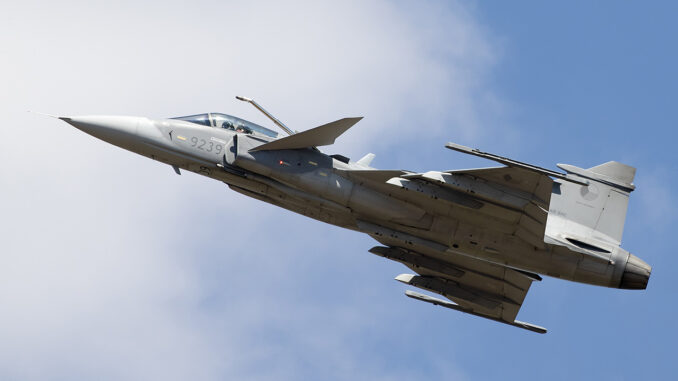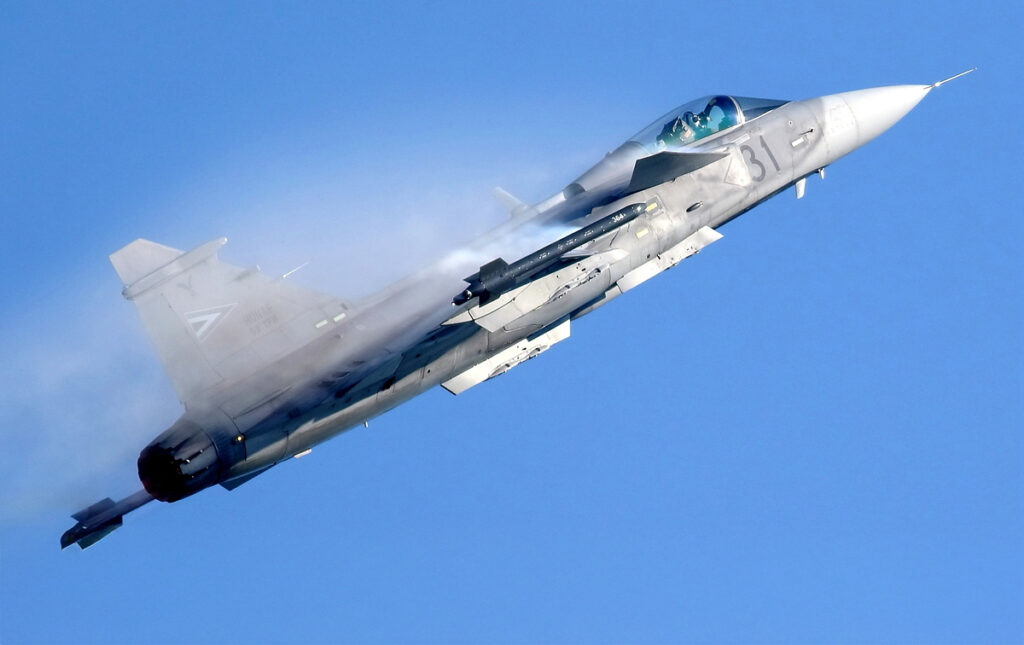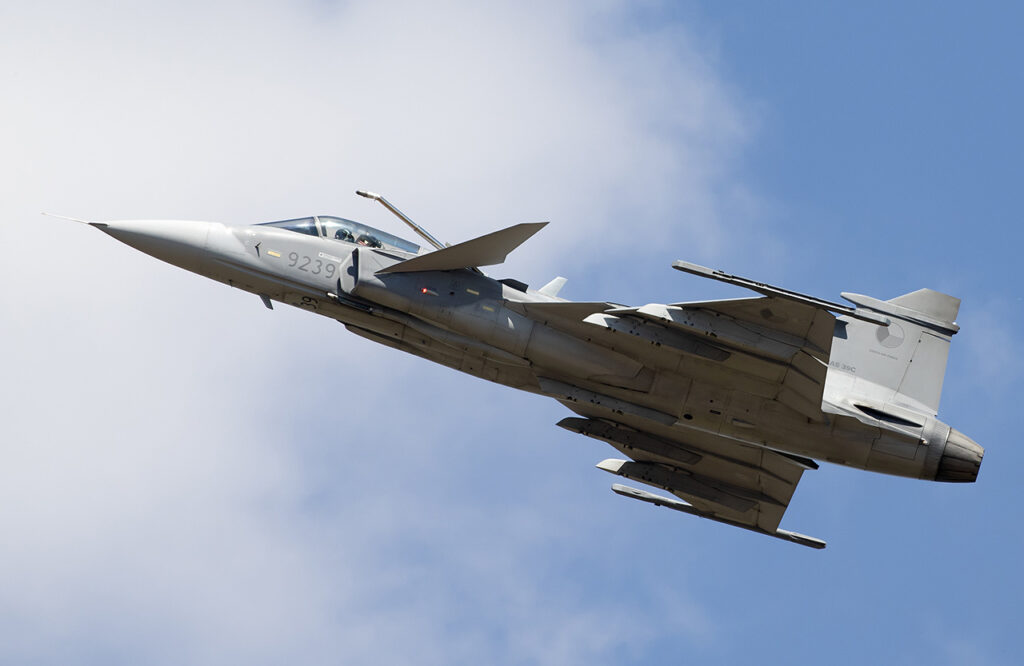
An analysis of the advantages of the Saab Gripen over other modern fighters: performance, cost, manoeuvrability, stealth.
The Saab Gripen, developed by the Swedish company Saab, is a multi-role fighter aircraft with several key advantages over other modern aircraft. These include superior manoeuvrability, low acquisition and maintenance costs, and advanced electronic warfare capabilities. With its modular design and optimised range, Gripen is designed to be effective in a variety of combat scenarios, while remaining accessible to many nations. This article explores in detail its technical characteristics and advantages over competing aircraft such as the F-16, Rafale or Eurofighter Typhoon.

Saab Gripen’s manoeuvrability and aerodynamic performance
The Saab Gripen is distinguished first and foremost by its exceptional manoeuvrability, which is a crucial element in modern air engagements. Thanks to an optimised aerodynamic design and the integration of fly-by-wire technology, Gripen can perform complex manoeuvres with a high degree of responsiveness. It is capable of tight turns and rapid heading changes, which are essential in dogfights.
Gripen’s architecture allows it to operate with a relatively low wing loading of 312 kg/m², providing better manoeuvrability than heavier aircraft such as the F-35 or Typhoon. Its ability to maintain cruising speed at high altitude (Mach 2) and excellent acceleration make it an asset in air-to-air and air-to-ground combat scenarios. The aircraft is powered by a Volvo RM12 engine capable of producing 54 kN of thrust in normal conditions, increased to 80 kN in afterburner mode, which contributes to its excellent acceleration performance.
Consequences of this manoeuvrability:
This manoeuvring capability enables Gripen pilots to react more quickly to threats and engage targets effectively in complex environments. The ability to execute aggressive manoeuvres while maintaining a high degree of stability in flight gives it a tactical advantage, particularly against heavier aircraft that may find it difficult to follow rapid changes of direction.
Low acquisition and maintenance costs
One of Saab Gripen’s key advantages over its competitors is its relatively low acquisition and maintenance costs. Gripen’s unit cost varies according to configuration, but is estimated at around €60 million, well below the costs of other fighters such as the F-35, which can exceed €80 million. This affordability makes it a popular choice for many nations looking to modernise their fleets within budgetary constraints.
In terms of maintenance, Gripen is designed to be simple to maintain, with reduced downtime. Saab’s engineers have developed a modular structure that allows damaged or worn parts to be replaced quickly. In addition, annual maintenance costs are estimated at €7,000 per flying hour, some 30% lower than for aircraft such as the F-16 or Typhoon. Gripen can also be operated from sparsely equipped bases or even from roads, further reducing infrastructure costs.
Consequences of this lower cost:
Air forces adopting Saab Gripen can maintain a larger and better maintained fleet while staying within budget. In addition, the ability to operate in austere conditions reduces the expense of logistics, a major constraint for many nations. Lower costs also allow greater flexibility in operations, as more aircraft can be available at all times.
Advanced electronic warfare capabilities
Gripen is equipped with advanced Electronic Warfare (EW) systems that enable it to jam, detect and neutralise threats before they can engage it. The Electronic Warfare Self-Protection System (EWSP)*, built into Gripen, includes radar jamming technologies, warning sensors and active countermeasures that make the aircraft difficult to target. This protects not only the aircraft itself, but also other air and ground units it may accompany.
One of the strengths of the Gripen EW is its modularity, which means that new systems can be integrated according to specific mission requirements or detected threats. For example, infrared countermeasure modules can be installed to counter heat-guided missiles. In comparison, aircraft such as the F-16 often require more costly and time-consuming upgrades to incorporate new electronic warfare technologies.
Consequences of these capabilities:
Saab Gripen’s ability to neutralise threats remotely significantly reduces the risk of damage and attrition of aircraft in combat. It also optimises attack, defence and reconnaissance missions. Jamming systems reduce reliance on escort fighters or specialist electronic warfare aircraft, improving overall operational effectiveness.
Stealth and low radar signature
Although Saab Gripen is not a stealth fighter in the strict sense, its low radar signature makes it more difficult to detect than many of its competitors. The airframe design has been optimised to minimise radar reflections, and its use of composite materials further reduces its footprint on enemy radars.
Compared to aircraft such as the F-35 or Su-57, which are specifically designed to be stealthy, Gripen offers ‘passive’ stealth, but remains more accessible and adaptable. It compensates for this limited stealth with the active use of its electronic warfare systems, making detection much more difficult in combination with deployed countermeasures.
Consequences of this stealth:
The use of a low radar signature allows Gripen to operate in contested airspace with a lower risk of being detected and engaged. This provides a strategic advantage for penetration and reconnaissance missions, without requiring massive investment in active stealth technologies.

Adaptability to air force operational requirements
Saab Gripen is designed with a modular philosophy that allows it to be easily adapted to the specific needs of each air force. This modularity applies to weapons, avionics, navigation and communication systems. For example, Gripen can integrate short- and long-range air-to-air missiles, as well as air-to-ground systems such as laser-guided bombs.
This flexibility allows Gripen to perform a variety of missions: air defence, ground attack, reconnaissance and electronic warfare. Countries such as Sweden, Hungary, Thailand and Brazil have integrated customised Gripen configurations to meet their specific needs.
The consequences of this adaptability:
Thanks to its modularity, air forces can easily update or modify their aircraft to meet new technological and tactical challenges. This reduces upgrade costs and extends the life of the fleet without having to buy new aircraft. This operational flexibility is particularly valuable for countries with smaller military budgets, as they can maximise their return on investment with scalable systems.
War Wings Daily is an independant magazine.